History of TOA
~From 1908 to 2008~
100th Anniversary Archive
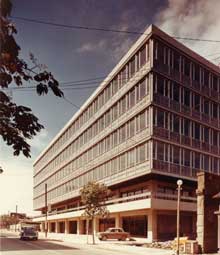
Part2 Surge in demand for reclaimed land for postwar reconstruction and during the rapid economic growth period 1946~1973
Industry moves into waterfront areas during postwar reconstruction
After the Pacific War ended on 14 September, 1945, the Allied Forces ordered the rehabilitation and extension of runway A at Haneda airfield. This was soon followed by a succession of new projects, such as dredging of Niigata Port for the Ministry of Transport and land reclamation at the Miike mine in Omuta for Mitsui Mining, as TOA Kowan Kogyo successfully rode the wave of postwar reconstruction demand in Japan.

Rehabilitation and extension of Haneda airfield
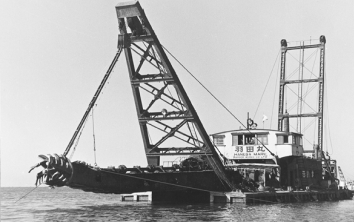
The Haneda-maru was used in reconstruction together with the Rokugo-maru

The pump dredger Musashi-maru was purchased by the U.S. military in 1952 to be used by the United States as a relief supply for Burma (present-day Myanmar)
HISTORY
- 11 September, 1945
- Forced relocation of head office due to building being requisitioned by the Allied Forces
- 16 May, 1949
- TOA Kowan Kogyo listed on Tokyo Stock Exchange
- 11 February, 1952
- Diesel-powered pump dredger Musashi-maru was purchased by U.S. military to be used as a relief supply for Burma
First phase of the land reclamation boom
The rapid domestic economic growth that began in the late 1950s prompted a spate of port and harbour projects and associated waterfront land reclamation works from 1958 onwards, and ushered in a key growth period for the reclamation and dredging industry. TOA Kowan Kogyo was able to build more pump dredgers and invest in new equipment, while the increased revenue helped to generate extra capital for the Company.
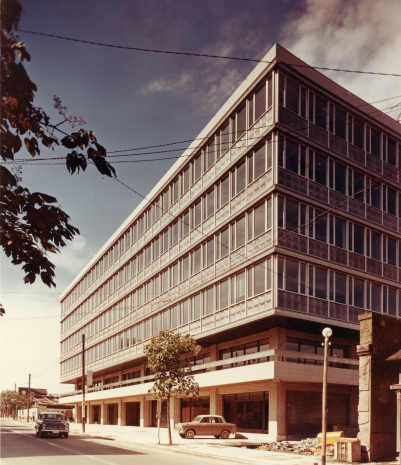
Former head office building shortly after completion. This location was used as head office until 2009.
HISTORY
- July 1957
- Work commenced on land development at the Kawasaki waterfront industrial zone (for the Kanagawa Prefecture Public Enterprises Agency)
- 1 October, 1957
- Established Keihin, Osaka, Shimonoseki and Hokkaido branches
- 4 March, 1961
- Inauguration ceremony for former head office building at Yonbancho, Chiyoda-ku, Tokyo
Land reclamation went nationwide
The 1962 Law to Promote the Establishment of New Industrial Cities generated fresh demand for waterfront land development, and TOA Kowan Kogyo was engaged in a number of projects including preparation of an industrial site for Kawasaki Steel at Mizushima in Okayama Prefecture, dredging of navigation channels for Mitsubishi Oil, and development of a waterfront industrial site for NKK at Fukuyama. The Company was also contracted for national projects such as the Kashima waterfront industrial precinct, which involved dredging of the central channel and construction of southern breakwaters.
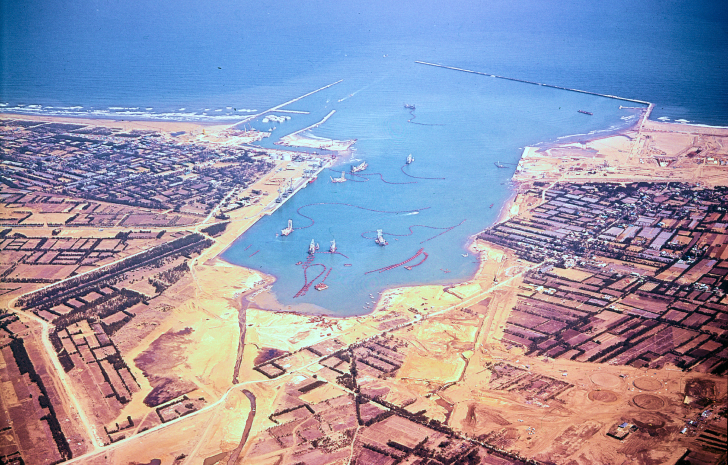
Dredging of the central channel at the Port of Kashima in the late 1960s
HISTORY
- January 1962
- First issue of the company newsletter "TOA"
- 11 November, 1963
- Established Overseas Department (Currently called as International Division)
Fiscal consolidation and corporate management plan
The Izanagi boom saw a sustained period of economic growth lasting for 56 consecutive months from late 1965 through to 1971, which brought high levels of investment in port and harbour development. However, during this time, the Company became more engaged in general civil engineering projects than dredging operations. Corporate management had moved on to capitalise on government economic policy.
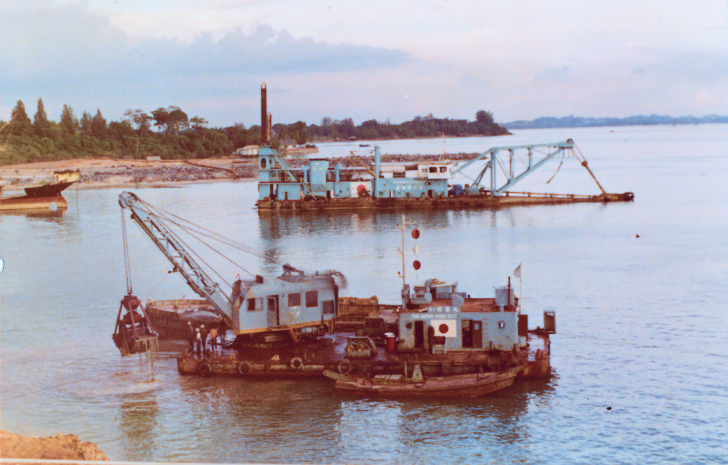
Dredging operations at Jurong, Singapore
HISTORY
- 4 August, 1964
- First postwar overseas project dredging at Jurong, Singapore for the Singapore Economic Development Board
The Company expanded into land-based projects and seeked to become a general civil engineering company
The formation of the Kakuei Tanaka cabinet in July 1972, on the back of a grand plan for remodeling the Japanese archipelago, led to yet another development boom and prompted TOA Kowan Kogyo to expand beyond port and harbour development into general civil engineering projects such as roads, bridges, building foundations and submerged tunnels, as well as residential land development over sea and land areas and even maritime developments.

Rail bed for Nishi-asa section of Sanyo Shinkansen (TOA Kowan Kogyo was also responsible for the bridges and viaducts), the company's first foray into construction of the bullet train network
Length = 960 m,
total embankment volume = 200,000m3
HISTORY
- 1971
- Purchased Sand Drain Barge No.1
- 1 February, 1972
- Established Nagoya branch